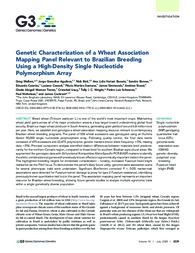Genetic characterization of a wheat association mapping panel relevant to brazilian breeding using a high-density single nucleotide polymorphism array.
Genetic characterization of a wheat association mapping panel relevant to brazilian breeding using a high-density single nucleotide polymorphism array.
Author(s): Mellers, G.; Aguilera, J. G.; Bird, N.; BONATO, A. L. V.; BONOW, S.; CAIERAO, E.; CONSOLI, L.; SANTANA, F. M.; Simmonds, J.; Steed, A.; TORRES, G. A. M.; Uauy, C.; Wright, T. I. C.; SCHEEREN, P. L.; Nicholson, P.; Cockram, J.
Summary: ABSTRACT Bread wheat (Triticum aestivum L.) is one of the world?s most important crops. Maintaining wheat yield gains across all of its major production areas is a key target toward underpinning global food security. Brazil is a major wheat producer in South America, generating grain yields of around 6.8 million tons per year. Here, we establish and genotype a wheat association mapping resource relevant to contemporary Brazilian wheat breeding programs. The panel of 558 wheat accessions was genotyped using an Illumina iSelect 90,000 single nucleotide polymorphism array. Following quality control, the final data matrix consisted of 470 accessions and 22,475 polymorphic genetic markers (minor allele frequency $5%, missing data ,5%). Principal component analysis identified distinct differences between materials bred predominantly for the northern Cerrado region, compared to those bred for southern Brazilian agricultural areas. We augmented the genotypic data with 26 functional Kompetitive Allele-Specific PCR (KASP) markers to identify the allelic combinations at genes with previously known effects on agronomically important traits in the panel. This highlighted breeding targets for immediate consideration ? notably, increased Fusarium head blight resistance via the Fhb1 locus. To demonstrate the panel?s likely future utility, genome-wide association scans for several phenotypic traits were undertaken. Significant (Bonferroni corrected P , 0.05) marker-trait associations were detected for Fusarium kernel damage (a proxy for type 2 Fusarium resistance), identifying previously known quantitative trait loci in the panel. This association mapping panel represents an important resource for Brazilian wheat breeding, allowing future genetic studies to analyze multiple agronomic traits within a single genetically diverse population.
Publication year: 2020
Types of publication: Journal article
Unit: Embrapa Wheat
Observation
Some of Embrapa's publications are published as ePub files. To read them, use or download one of the following free software options to your computer or mobile device. Android: Google Play Books; IOS: iBooks; Windows and Linux: Calibre.
Access other publications
Access the Agricultural Research Database (BDPA) to consult Embrapa's full library collection and records.
Visit Embrapa Bookstore to purchase books and other publications sold by Embrapa.

